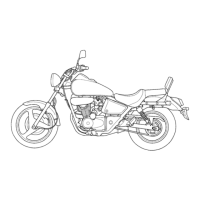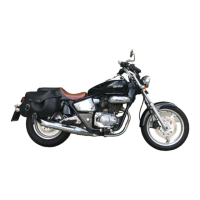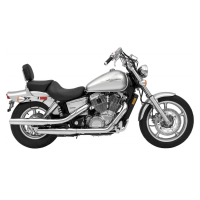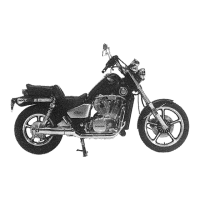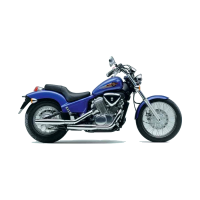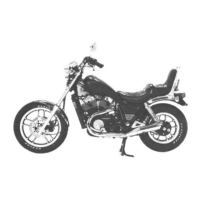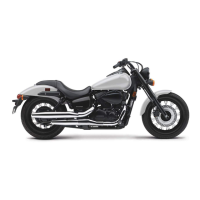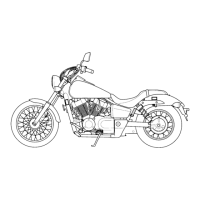Do you have a question about the Honda Shadow Phantom 2020 and is the answer not in the manual?
Guidance on enhancing rider safety through proper practices and precautions.
Information on important safety and hazard warning labels found on the vehicle.
Essential precautions for safe operation and passenger safety, including protective gear.
Guidelines for safe riding, including break-in, brakes, and handling different conditions.
Advice on accessories and modifications to maintain vehicle safety and legality.
Instructions and warnings regarding proper loading to maintain vehicle stability and safety.
Explanation of why regular maintenance is crucial for vehicle safety, performance, and longevity.
Detailed schedule outlining recommended maintenance tasks based on mileage and time intervals.
A logbook for recording completed maintenance services and dates for tracking.
Basic principles and procedures for performing vehicle maintenance safely and effectively.
Procedures for safely removing and reinstalling major body components like the seat and covers.
Diagnosing and resolving issues when the engine fails to start or the starter motor operates.
Identifying causes and solutions for engine overheating, indicated by the high coolant temperature warning.
Understanding and responding to illuminated or flashing warning lights like oil pressure and PGM-FI.
Procedures for addressing tire punctures, including repair, replacement, and wheel removal.
Details on ignition and steering lock keys, including making duplicates and key number recording.
Overview of vehicle instruments, controls, ignition cut-off system, and document storage.
Guidelines for washing, polishing, and maintaining vehicle appearance and components.
Instructions for preparing and storing the vehicle for extended periods, including battery care.
Recommended methods and precautions for safely transporting the vehicle.
Information on responsible vehicle use, including eco-friendly cleaners and waste recycling.
Locating and recording the VIN and engine serial number for registration and parts ordering.
Explanation of the vehicle's emission control systems and requirements for compliance.
Information on the function of catalytic converters and guidelines to protect them.
Advice on using oxygenated fuels and potential issues, including damage to fuel system components.
Information on obtaining service manuals, common service manuals, and winter storage guides.
Details on vehicle warranty coverage, exclusions, and procedures for service and repairs.
Contact information for American Honda Motor Co. and local Honda dealers for support.
How to report potential safety defects to NHTSA and American Honda Motor Co.
Key physical dimensions and weight specifications for the vehicle.
Technical data including tire sizes, pressures, spark plugs, oil, and fluid capacities.
Specifications for various vehicle light bulbs, including voltage and wattage.
Required torque values for critical fasteners and components during maintenance and assembly.
Guidance on enhancing rider safety through proper practices and precautions.
Information on important safety and hazard warning labels found on the vehicle.
Essential precautions for safe operation and passenger safety, including protective gear.
Guidelines for safe riding, including break-in, brakes, and handling different conditions.
Advice on accessories and modifications to maintain vehicle safety and legality.
Instructions and warnings regarding proper loading to maintain vehicle stability and safety.
Explanation of why regular maintenance is crucial for vehicle safety, performance, and longevity.
Detailed schedule outlining recommended maintenance tasks based on mileage and time intervals.
A logbook for recording completed maintenance services and dates for tracking.
Basic principles and procedures for performing vehicle maintenance safely and effectively.
Procedures for safely removing and reinstalling major body components like the seat and covers.
Diagnosing and resolving issues when the engine fails to start or the starter motor operates.
Identifying causes and solutions for engine overheating, indicated by the high coolant temperature warning.
Understanding and responding to illuminated or flashing warning lights like oil pressure and PGM-FI.
Procedures for addressing tire punctures, including repair, replacement, and wheel removal.
Details on ignition and steering lock keys, including making duplicates and key number recording.
Overview of vehicle instruments, controls, ignition cut-off system, and document storage.
Guidelines for washing, polishing, and maintaining vehicle appearance and components.
Instructions for preparing and storing the vehicle for extended periods, including battery care.
Recommended methods and precautions for safely transporting the vehicle.
Information on responsible vehicle use, including eco-friendly cleaners and waste recycling.
Locating and recording the VIN and engine serial number for registration and parts ordering.
Explanation of the vehicle's emission control systems and requirements for compliance.
Information on the function of catalytic converters and guidelines to protect them.
Advice on using oxygenated fuels and potential issues, including damage to fuel system components.
Information on obtaining service manuals, common service manuals, and winter storage guides.
Details on vehicle warranty coverage, exclusions, and procedures for service and repairs.
Contact information for American Honda Motor Co. and local Honda dealers for support.
How to report potential safety defects to NHTSA and American Honda Motor Co.
Key physical dimensions and weight specifications for the vehicle.
Technical data including tire sizes, pressures, spark plugs, oil, and fluid capacities.
Specifications for various vehicle light bulbs, including voltage and wattage.
Required torque values for critical fasteners and components during maintenance and assembly.
| Compression Ratio | 9.6:1 |
|---|---|
| Transmission | Wide-ratio five-speed |
| Final Drive | Shaft |
| Front Suspension | 41mm fork; 4.6 inches travel |
| Front Brake | Single 296mm disc with twin-piston caliper |
| Rear Brake | Drum |
| Front Tire | 120/90-17 |
| Rear Tire | 160/80-15 |
| Rake | 34° |
| Wheelbase | 64.6 inches |
| Seat Height | 25.6 inches |
| Curb Weight | 549 pounds |
| Fuel Capacity | 3.7 gallons |
| Available Colors | Matte Black Metallic |
| Engine Type | 745cc liquid-cooled 52 degrees V-twin |
| Bore and Stroke | 79.0mm x 76.0mm |
| Induction | PGM-FI, 34mm throttle body |
| Rear Suspension | Dual shocks with five-position spring-preload adjustability |
| Trail | 6.3 inches |

